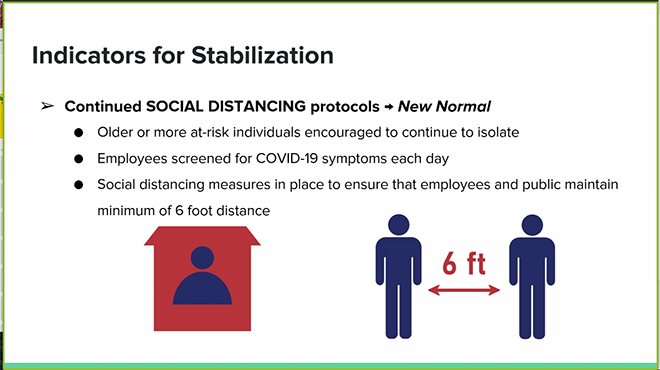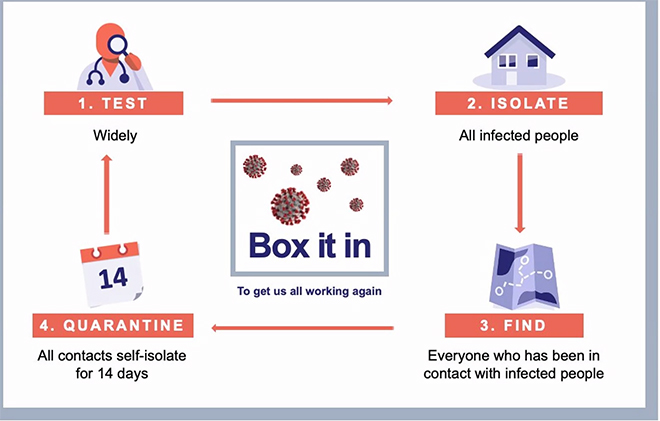“It’s a pretty narrow range for us to be successful.”
By Katherine Nettles
Local health officials are ready to “dance” as a new chapter in the Gunnison County COVID-19 quarantine is about to begin. But the dance will be a delicate one.
Gunnison County plans to issue a new public health order with slightly fewer restrictions by Sunday afternoon, April 26, and enter a first stage of returning to normalcy—if things go well. This next stage will have lighter restrictions than those currently in place but still mandate things like social distancing and encourage the high-risk population to stay isolated. It is likely to last four to eight weeks as officials monitor the containment of the virus..
Gunnison County public health director Joni Reynolds briefed county commissioners and other county staff on Thursday about starting a process for moving forward, which might include more flexibility to conducting business, re-opening childcare for essential workers, and loosening some restrictions on traveling to and from Gunnison County including for people with second homes in the area. Many aspects will parallel state orders, as those details get ironed out.
Despite the lack of adequate testing available, which Reynolds said last week was an important part of the re-opening process, Reynolds indicated Thursday that both state recommendations and Gunnison’s apparent success in flattening the curve of disease spread among its residents indicate it may be time to move away from the strictest public health orders of the past several weeks.
“My intent, to the extent possible, is to outline where we’re heading,” she said. And she painted a picture of life that may include travel, tourism, childcare, access to libraries, allowing slightly larger group gatherings and more business conducted. We seem to be heading into what is called the “Dance” stage,” defined in an essay titled Coronavirus: the Hammer and the Dance by Tomas Pueyo last month. This stage will move toward ever-loosening restrictions, if the number of cases remains relatively flat, while maintaining test sites, collecting data and mitigating risks and scattered outbreaks.
The first stage, said Reynolds, will be a trial period for four to eight weeks. And it is possible, of course, that setbacks will reverse the process and stricter orders will return.
Reynolds said that social distancing protocols are expected to be the new normal, in both work places and in public. “I expect to see these in the public health orders for the foreseeable future,” she said.
But offices might be able to reopen, if they can maintain sanitation practices and social distancing. The library is also a consideration for opening with restrictions, said Reynolds.
Childcare is still under discussion, she said, but making it available to essential workers with social distancing modification is a priority.
“I think folks have a little bit of anxiety about childcare reopening, and I think anxiety equates to vigilance. So, I appreciate it,” she said. Guidelines for keeping the same group of kids together in the same room, separate from others and maintaining lower capacity will come into play.
“The less we mix and match will be beneficial,” she said of childcare centers. “It’s still something I want to monitor closely…I’m picturing a lot of problems for kids wearing masks,” she pointed out. Others in the room quipped about the likelihood of keeping toddlers in masks, which would not be possible or mandatory.
Those community members at higher risk will still be encouraged to isolate themselves, and careful screenings of employees would be important across all industries.
And the much discussed part-time residents of Gunnison County may also be allowed to visit, with a requirement that they inform public health officials first and self-isolate for a period of seven days after they arrive. Other visitors, who might want to come for a weekend, were not yet part of the plan.
If other counties also allow for it, Reynolds said she anticipates that residents who leave the county for more than 24 hours need to self-isolate for seven days, but if their trip is less than 24 hours in duration, they will not be required to do that.
Many of the changes coming for Gunnison County are behind those of other areas, noted Reynolds, and Gunnison County will shape its own health orders to the unique considerations here. Still, many of those will fall in line with state orders. Reynolds said her team still needs clarity on some of the governor’s recommendations, including metrics and the reasoning behind them.
Another change ahead, said Reynolds, is an overall different approach to the public health orders. Reynolds acknowledged that she can provide more narrative behind the orders and pledged to make the reasoning more available to the public.
“There are many more months ahead. And I want to raise the bar for more transparency and to tailor Gunnison County recommendations to this county,” she said.
She said she is hoping to find a public dashboard of some sort, to give people a real-time view of where things are at any given point in time. Her presentation included several charts and guidelines to this effect, some of which came from the governor’s office and some which came from Johns Hopkins University, and some which came from Gunnison County. “It’s a pretty narrow range for us to be successful.”
“I think of this as really the lowest risk phase and want it to be successful,” she said.
Commissioner Roland Mason asked, “As we continue this dance, as things change day to day, how can we get this information out the public…so they understand the ebb and flow over the next few weeks?”
Reynolds responded that she is hoping the dashboard and narrative approach will help. She is also hoping to have a very regular schedule for changes or updates that people can anticipate.
Commissioner Jonathan Houck asked if businesses can have a little lead time if they are going to be allowed to reopen but be required to meet new health regulations for sanitizing, for instance. Reynolds responded that they didn’t have those details ready yet, and commissioner John Messner suggested that businesses all do that now anyway.
“Whether it’s Clorox wipes, additional cleaning supplies, etc.,” he said, “And I think it’s clear for all of Gunnison County that we all need to acquire masks.”
Messner said he thinks the next phase will be the most important one and will determine the ultimate success of Gunnison County’s future.
“This stage ends up being the most important thing to community engagement to this point. The community has been incredible as far as how they’ve addressed the Hammer stage of this, the steps they’ve been taking, the willingness to put community above self,” he said. But the next stage puts even more responsibility on the community to make sure they continue the social distancing, wearing masks, using hand sanitizer, and taking responsibility for employees and customers.
“And I have every faith that we will be able to do that,” he added.
Reynolds agreed. “I actually think the first phase of saying what can’t be done…is ultimately the easiest phase. Which is really striking to say. I think the next phase is going to be challenging …as we really figure out how to monitor and adjust as necessary. But I also think this valley is full of creative and amazing people that will find ways to kind of reinvent events and traditions and things that we never thought would be feasible, but in ways that will surprise all of us,” she said.
“And some of our traditions and some of our events will change in ways for the better,” she added.
 The Crested Butte News Serving the Gunnison Valley since 1999
The Crested Butte News Serving the Gunnison Valley since 1999




